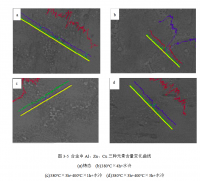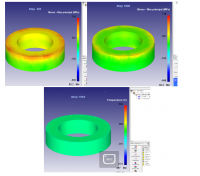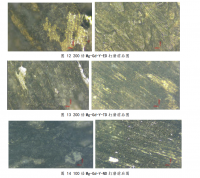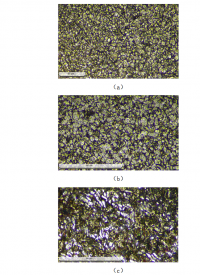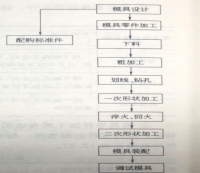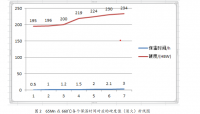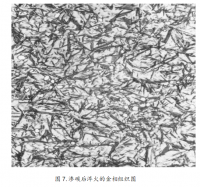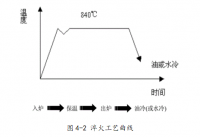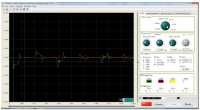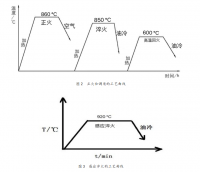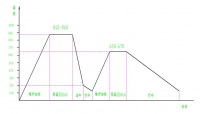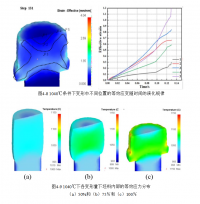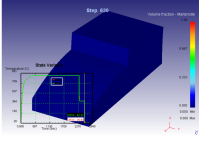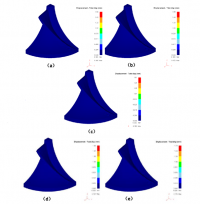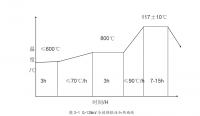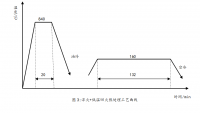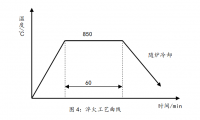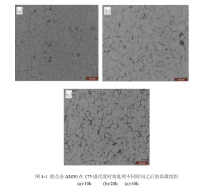合金化及热处理对ZA40合金微观组织和性能的影响
摘要:本文研究了合金化与热处理对ZA40合金微观组织和性能的影响,由最后的试验结果得出了最适合高铝锌合金的热处理工艺方案。铜元素在合金中会对其有性能和微观组织的影响,因此,对合金中的铜元素也做了一定的试验分析。在合金中不同的元素有着各自的分布,元素不同的分布方式对合金的性能在一定程度上会产生影响,由此可以知道不同的热处理工艺对合金内部元素分布有着不同的影响,为了给试验结果探索到最适合锌铝合金的热处理工艺方案提供足够的证明。本文主要研究内容如下所示:
锌铝合金的内部组织结构主要由α+η共析体和α相树枝状枝晶组成。在锌铝合金中加入少量的铜元素对合金内部组织结构不会产生太大的影响。当添加到合金中的铜元素含量较低的时候,铜元素主要以铝、锌元素为溶剂的方式存在于固溶体当中;当合金中加入的铜元含量素较多的时候(通常超过3%),在晶界周围,Cu和Zn两种元素就会发生反应,从中析出ε相。随着合金中加入的铜元素持续上升,则合金中的ε相数量也会持续上升。
在合金中,随着铜元素含量的不断升高(0-5%Cu),合金的硬度也会随之提高。在能够提高合金硬度的所有因素当中,固溶强化为首要因素。Zn-40Al-4Cu合金在进行完固溶处理后,其内部元素在合金中呈均匀分布,且合金中的树枝晶由原来的细条状转变成块状;随着固溶处理时间的增长,合金中α相的数量会有所增加,而合金中共析体的数量,相对于之前会有所减少;ε相的形状会变得较为圆整且数目和尺寸都会有所减小。Zn-40Al-4Cu合金进行完固溶处理后,其硬度与耐磨性相对于固溶处理前会有所提高;当固溶时间达到一定程度后,其布氏硬度与之前相比会有所下降,且合金中α相的硬度会不断提高,保持上升趋势,而合金中共析体的硬度却一直下降,持下降趋势。
关键词:锌铝合金;固溶处理;分级热处理
Effect of Alloying and Heat Treatment on Microstructure and Properties of ZA40 Alloy
Abstract: The effect of alloying and heat treatment on microstructure and properties of ZA40 alloy is studied in this paper. The influence of the copper element on the properties and microstructure of the alloy is also studied. The different elements in the alloy have their own distribution, and the distribution of the elements has an effect on the properties of the alloy to a certain extent, so that different heat treatment processes can be known to have different influences on the internal element distribution of the alloy, in ord to find that most suitable heat for the zinc-aluminum alloy for the test results, The treatment process provides sufficient proof. The main contents of this paper are as follows:
The inner structure of Zn-Al alloy is mainly composed of α + η-eutectic and α-phase dendrite. The addition of a small amount of copper in Zn-Al alloy does not have much effect on the internal structure of the alloy. When the content of copper added to the alloy is low, the copper element is mainly in the form of aluminum and zinc as solvent in the solid solution. When more copper elements are added to the alloy (usually more than 3%), two elements, Cu and Zn, react around the grain boundary, from which ε phase is precipitated. As the addition of copper in the alloy continues to increase, the number of ε phases in the alloy will continue to increase.
The hardness of the alloy increases with the increasing content of copper (0-5%Cu) in the alloy. Among all the factors that can improve the hardness of the alloy, solid solution strengthening is the most important factor. After solid solution treatment, the internal elements of Zn-40Al-4Cu alloy are uniformly distributed in the alloy. The dendrite in the alloy changed from the original thin strip to the block. With the increase of solution treatment time, the amount of α phase in the alloy will increase, but the number of eutectic phase will decrease. The shape of ε phase will become more round and the number and size of ε phase will decrease. -after solid solution treatment, the hardness and wear resistance of 40Al-4Cu alloy will be improved compared with that before solution treatment. When the solution time reaches a certain extent, the Brinell hardness of the alloy will decrease, and the hardness of α phase in the alloy will continue to increase and keep increasing, while the hardness of the alloy eutectic will keep decreasing.
Key words: zinc-aluminum alloy; solution treatment; graded heat treatment.
目录
第一章 绪论 4
1.1 锌铝合金概述 4
1.1.1、合金元素 4
1.1.2、合金相图 5
1.1.3、合金相变过程 5
1.1.4、合金的相及性能 6
1.2改进锌铝合金性能的方法与措施 6
1.2.1、改善合金成分 6
1.2.2、控制锌铝合金的凝固过程 8
1.2.3、改善合金的热处理工艺 9
1.3、本论文的研究意义于内容 9
1.3.1、研究的意义 9
1.3.2、研究内容 10
第二章 Cu元素对锌铝合金组织与性能产生的影响 11
2.1 实验过程 11
2.1.1 合金熔炼 11
2.1.2 准备试样与性能测试 13
2.2 实验结果与分析 13
2.2.1 Cu元素对锌铝合金内部组织的影响 13
2.2.2 Cu元素对合金硬度的影响 15
2.3 本章小结 17
第三章 热处理工艺对ZA40合金组织与性能的影响 18
3.1 实验过程 18
3.2 最佳热处理方案的探索 19
3.2.1 热处理方案的设计 19
3.2.2 热处理工艺对合金金相组织的影响 20
3.2.3 热处理工艺对合金硬度的影响 24
第四章 结论 28
参考文献 29
致谢 29
第一章绪论
1.1锌铝合金概述
锌铝合金最早是出现在第二次世界大战前期,德国为了能够解决铜资源匮乏的问题,就开始致力于研究铸造锌合金来替代铜合金。最后研究结果表明,用铸造锌合金研发的轴承,其性能可部分替代以往传统的锡青铜。在上个世纪60年代,国际铅锌研究组织在美国研发出了新型的高铝锌合金ILZRO-12、ILZRO-14、ILZRO-16。随后几年,加拿大的一家矿业公司在前者研发的基础上,又对合金进行了进一步的改善,最终推出了以ZA12命名的锌合金并且又在此基础上继续研发了合金中含铝量不同的ZA27、ZA8合金,形成了后来的ZA系列高铝锌合金。我国的铜资源储量相对于锌资源而言,显得较为薄弱,因此研发锌铝合金来替代部分铜合金具有很高的社会价值与经济价值[1][2]。
但,锌铝合金在有些性能方面上也存在着一些缺陷。例如锌铝合金在凝固过程中会发生糊状凝固,除此之外,由锌铝合金溶液所浇注成的铸件会存在着补缩困难的情况,这会导致在合金内部形成显微缩松和成分偏析的现象。在锌铝合金内部组织结构中,当合金中加入适量的铜元素,对提高合金的强度和耐磨性有很大帮助,但在之后的时效过程里合金中所含的铜元素会引起合金发生组织上的转变。锌铝合金作为一种耐磨材料,对其所在的工作温度有一定要求,即工作温度低于150℃。因此,锌铝合金的耐高温性能也成为了锌铝合金要解决的一项问题[3]。
参考文献
[1]高仑.锌与锌合金及应用[M]北京:化学工业出版社,2011.
[2]胡赛育.发展中的锌铝合金及其应用[J]. 机械工程材料,1998,(4).
[3]H. Cuvalci,H. S. Celik.Investigation of the abrasive wear behaviour of ZA-27 alloy and CuSn10 bronze [J].Journal of Materials Science,2011,(14):4850-4857.
[4]A. Türk, C. Kurnaz, H. Sevik. Comparison of the wear properties of modified ZA-8 alloys and conventional bearing bronze [J]. Materials & Design, 2007(6):1889-1897.
[5]田荣璋.中国有色金属丛书—锌合金[M]长沙:中南大学出版社,2010.
[6]李建春.锰、铜含量对锌铝合金组织与性能的影响[J]. 理化实验-物理分册,2009,45(6):331-363.
[7] 司乃潮,傅明喜.有色金属材料及制备[M]北京:化学工业出版社,2006
[8] 闫淑卿.高铝锌合金—ZA48组织和性能研究[M]北京:中国水利水电出版社 2015
[9] 王振杰,夏兰廷,蔺虹宾等. Sb对含硅ZA40合金耐磨性及尺寸稳定性的影响[J]. 铸造设备与工2009, (4):18-20+26.
[10]李祥,薛涛,等,古文全. RE对ZA43合金组织、力学性能及抗磨性的影响[J]. 特种铸造及有色合金,2007,(05).
[11]李荣德,马立国,李晨希等. 稀土Ce对ZA27合金组织和力学性能的影响[J]. 沈阳工业大学学报,2007 ,(3):250-253.
[12] 白彦华,石瑛楠,李荣德. 挤压铸造ZA27合金的力学性能及摩擦磨损性能[J]. 沈阳工业大学学报2008, (1):73-76.
[13] 李傅红,变质处理对ZAS35合金力学性能的影响[J].轻合金加工技术,2003,(6)
[14] B.K.Prasad. Influence of heat treatment parameters on the lubricated sliding wear behaviour of a zinc-based alloy [J]. Wear,2004, 257(11):1137-1144.
[15] 沈言锦. ZA40合金热处理工艺的确定[J]. 理化实验-物理分册,2009,45(11):678-679.



